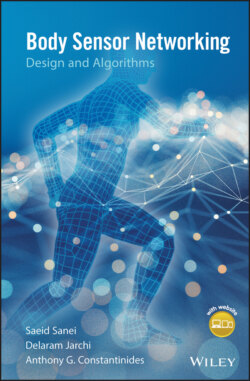Читать книгу Body Sensor Networking, Design and Algorithms - Saeid Sanei - Страница 25
3.2.1 Accelerometer and Its Application to Gait Monitoring
ОглавлениеTraditional optical motion capture systems, by means of video cameras, have long been used for human gait analysis, and some clinics and motion laboratories have adopted them as a classic way of motion monitoring. These systems include a stationary system such as a treadmill surrounded by a number of video cameras. Obviously, the main limitation for using such sensors is that the subjects have to move and perform in a limited space within the laboratory so they can be captured by a number of cameras installed around that region. In addition, although such systems can perform highly accurate human motion analysis, they are a relatively expensive platform and require expert operation [19]. Finally, for patient monitoring and assistive technology, such systems are subject to privacy breach and therefore have limited application, particularly when the system is to be deployed for monitoring a wider community of patients, athletes, and so on.
In [20] a comprehensive review of accelerometers has been provided. Presently, by itself or as part of an IMU, accelerometers find applications in consumer devices such as digital cameras, health trackers, smartphones, cars, and interactive computer games. In less prominent applications, accelerometers are used in some industrial environments, such as for measuring vibrations between motors and their mountings and for measuring tilt. All these require accelerometers to provide higher sensitivity, robustness, and smaller size at a lower cost. As a result, accelerometers have proven very useful for in vivo movement analysis.
Sensor deployment to both environmental and human body communication networks has led to many important applications. For example, the method of placement and attachment of the sensor to human body for optimal sensing and analysis of the captured data has to be studied and taken into account in the design of the whole system.
Commonly used accelerometer types are piezoelectric, thermal, and capacitive, the last one is usually fabricated using micro-electromechanical sensor (MEMS) technology, which is also the lowest in cost because of so-called economies of scale.
A piezoelectric accelerometer exploits the piezoelectric effect of certain materials to measure dynamic changes in mechanical variables. Figure 3.1 shows the operation mechanism of such a device [21].
Unlike piezoelectric or capacitance type MEMS accelerometers, which use solid mass structures, the thermal method uses heated gas and thermocouples, and thus has no moving parts. It measures the temperature difference between the cooler and the warmer air [22].
Figure 3.1 The mechanism of a piezoelectric accelerometer.
Currently, most work into the simulation of accelerometers deals with verifying a design at the semiconductor fabrication level.
There are three major challenges in the design and use of accelerometers. The first is the effect of drift or change in the internal mechanical or electrical properties, which can manifest itself as a bias or an offset in readings. The second is noise from amplified microscopic mechanical motions, which needs to be reduced if not eliminated. The third is the effect of gravity, which is ever present. While this is strictly not a defect, we have to consider that the gravitational force vector is projected and superimposed along the axes of sensitivity of the accelerometer. Thus, the movements along these axes experience a confounding gravitational effect. Furthermore, with movements at frequencies beyond 10 kHz, the internal mechanical parts of an accelerometer move nonlinearly, resulting in dynamic errors.
